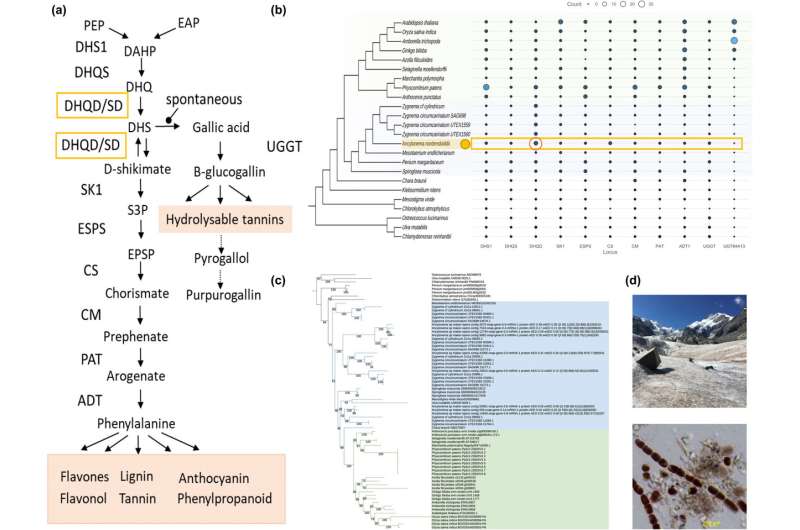Comparative genomics of purpurogallin biosynthesis. Credit: New Phytologist (2024). DOI: 10.1111/nph.19860
People often underestimate tiny beings. But microscopic algal cells not only evolved to thrive in one of the most extreme habitats on Earth—glaciers—but are also shaping them.
With a team of scientists from the UK and Canada, we traced the evolution of purple algae back hundreds of millions of years and our findings challenge a key idea about how evolution works. Though small, these algae are having a dramatic effect on the glaciers they live on.
Glaciers are among the planet's fastest changing ecosystems. During the summer melt season, as liquid water forms on glaciers, blooms of purple algae darken the surface of the ice, accelerating the rate of melt. This fascinating adaptation to glaciers requires microscopic algae to control their growth and photosynthesis. This must be balanced with tolerance of extreme ice melt, temperature and light exposure.
Our study, published in New Phytologist, reveals how and when their adaptations to live in these extreme environments first evolved. We sequenced and analyzed genome data of the glacier algae Ancylonema nordenskiöldii. Our results show that the purple color of glacier algae, which acts like a sunscreen, was generated by new genes involved in pigment production.
This pigment, purpurogallin, protects algal cells from damage of ultraviolet (UV) and visible light. It is also linked with tolerance of low temperatures and desiccation, characteristic features of glacial environments. Our genetic analysis suggests that the evolution of this purple pigment was probably vital for several adaptations in glacier algae.
We also identified new genes that helped increase the algae's tolerance to UV and visible light, important adaptations for living in a bright, exposed environment. Interestingly, these were linked to increased light perception as well as improved mechanisms of repair of sun damage. This work reveals how algae are adapted to live on glaciers in the present day.
Next, we wanted to understand when this adaptation evolved in Earth's deep history.
The evolution of glacier algae
Earth has experienced many fluctuations of colder and warmer climates. Across thousands and sometimes millions of years, global climates have changed slowly between glacial (cold) to interglacial (warm) periods.
One of the most dramatic cold periods was the Cryogenian, dating back to 720-635 million years ago, when Earth was almost entirely covered in snow and ice. So widespread were these glaciations, they are sometimes referred to by scientists as "Snowball Earth".
Scientists think that these conditions would have been similar to the glaciers and ice sheets we see on Earth today. So we wondered: Could this period be the force driving the evolution of glacier algae?
After analyzing genetic data and fossilized algae, we estimated that glacier algae evolved around 520-455 million years ago. This suggests that the evolution of glacier algae was not linked to the Snowball Earth environments of the Cryogenian.
As the origin of glacier algae is later than the Cryogenian, a more recent glacial period must have been the driver of glacial adaptations in algae. Scientists think there had continuously been glacial environments on Earth up to 60 million years ago.
More information: Alexander M. C. Bowles et al, Metagenome‐assembled genome of the glacier alga Ancylonema yields insights into the evolution of streptophyte life on ice and land, New Phytologist (2024). DOI: 10.1111/nph.19860
Journal information: New Phytologist
Provided by The Conversation
This article is republished from The Conversation under a Creative Commons license. Read the original article.![]()
























